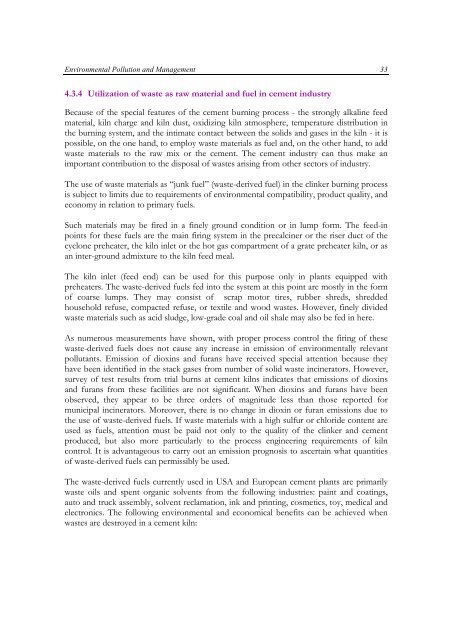technology, energy efficiency and environmental externalities in the ...
technology, energy efficiency and environmental externalities in the ...
technology, energy efficiency and environmental externalities in the ...
You also want an ePaper? Increase the reach of your titles
YUMPU automatically turns print PDFs into web optimized ePapers that Google loves.
Environmental Pollution <strong>and</strong> Management 33<br />
4.3.4 Utilization of waste as raw material <strong>and</strong> fuel <strong>in</strong> cement <strong>in</strong>dustry<br />
Because of <strong>the</strong> special features of <strong>the</strong> cement burn<strong>in</strong>g process - <strong>the</strong> strongly alkal<strong>in</strong>e feed<br />
material, kiln charge <strong>and</strong> kiln dust, oxidiz<strong>in</strong>g kiln atmosphere, temperature distribution <strong>in</strong><br />
<strong>the</strong> burn<strong>in</strong>g system, <strong>and</strong> <strong>the</strong> <strong>in</strong>timate contact between <strong>the</strong> solids <strong>and</strong> gases <strong>in</strong> <strong>the</strong> kiln - it is<br />
possible, on <strong>the</strong> one h<strong>and</strong>, to employ waste materials as fuel <strong>and</strong>, on <strong>the</strong> o<strong>the</strong>r h<strong>and</strong>, to add<br />
waste materials to <strong>the</strong> raw mix or <strong>the</strong> cement. The cement <strong>in</strong>dustry can thus make an<br />
important contribution to <strong>the</strong> disposal of wastes aris<strong>in</strong>g from o<strong>the</strong>r sectors of <strong>in</strong>dustry.<br />
The use of waste materials as “junk fuel” (waste-derived fuel) <strong>in</strong> <strong>the</strong> cl<strong>in</strong>ker burn<strong>in</strong>g process<br />
is subject to limits due to requirements of <strong>environmental</strong> compatibility, product quality, <strong>and</strong><br />
economy <strong>in</strong> relation to primary fuels.<br />
Such materials may be fired <strong>in</strong> a f<strong>in</strong>ely ground condition or <strong>in</strong> lump form. The feed-<strong>in</strong><br />
po<strong>in</strong>ts for <strong>the</strong>se fuels are <strong>the</strong> ma<strong>in</strong> fir<strong>in</strong>g system <strong>in</strong> <strong>the</strong> precalc<strong>in</strong>er or <strong>the</strong> riser duct of <strong>the</strong><br />
cyclone preheater, <strong>the</strong> kiln <strong>in</strong>let or <strong>the</strong> hot gas compartment of a grate preheater kiln, or as<br />
an <strong>in</strong>ter-ground admixture to <strong>the</strong> kiln feed meal.<br />
The kiln <strong>in</strong>let (feed end) can be used for this purpose only <strong>in</strong> plants equipped with<br />
preheaters. The waste-derived fuels fed <strong>in</strong>to <strong>the</strong> system at this po<strong>in</strong>t are mostly <strong>in</strong> <strong>the</strong> form<br />
of coarse lumps. They may consist of scrap motor tires, rubber shreds, shredded<br />
household refuse, compacted refuse, or textile <strong>and</strong> wood wastes. However, f<strong>in</strong>ely divided<br />
waste materials such as acid sludge, low-grade coal <strong>and</strong> oil shale may also be fed <strong>in</strong> here.<br />
As numerous measurements have shown, with proper process control <strong>the</strong> fir<strong>in</strong>g of <strong>the</strong>se<br />
waste-derived fuels does not cause any <strong>in</strong>crease <strong>in</strong> emission of <strong>environmental</strong>ly relevant<br />
pollutants. Emission of diox<strong>in</strong>s <strong>and</strong> furans have received special attention because <strong>the</strong>y<br />
have been identified <strong>in</strong> <strong>the</strong> stack gases from number of solid waste <strong>in</strong>c<strong>in</strong>erators. However,<br />
survey of test results from trial burns at cement kilns <strong>in</strong>dicates that emissions of diox<strong>in</strong>s<br />
<strong>and</strong> furans from <strong>the</strong>se facilities are not significant. When diox<strong>in</strong>s <strong>and</strong> furans have been<br />
observed, <strong>the</strong>y appear to be three orders of magnitude less than those reported for<br />
municipal <strong>in</strong>c<strong>in</strong>erators. Moreover, <strong>the</strong>re is no change <strong>in</strong> diox<strong>in</strong> or furan emissions due to<br />
<strong>the</strong> use of waste-derived fuels. If waste materials with a high sulfur or chloride content are<br />
used as fuels, attention must be paid not only to <strong>the</strong> quality of <strong>the</strong> cl<strong>in</strong>ker <strong>and</strong> cement<br />
produced, but also more particularly to <strong>the</strong> process eng<strong>in</strong>eer<strong>in</strong>g requirements of kiln<br />
control. It is advantageous to carry out an emission prognosis to ascerta<strong>in</strong> what quantities<br />
of waste-derived fuels can permissibly be used.<br />
The waste-derived fuels currently used <strong>in</strong> USA <strong>and</strong> European cement plants are primarily<br />
waste oils <strong>and</strong> spent organic solvents from <strong>the</strong> follow<strong>in</strong>g <strong>in</strong>dustries: pa<strong>in</strong>t <strong>and</strong> coat<strong>in</strong>gs,<br />
auto <strong>and</strong> truck assembly, solvent reclamation, <strong>in</strong>k <strong>and</strong> pr<strong>in</strong>t<strong>in</strong>g, cosmetics, toy, medical <strong>and</strong><br />
electronics. The follow<strong>in</strong>g <strong>environmental</strong> <strong>and</strong> economical benefits can be achieved when<br />
wastes are destroyed <strong>in</strong> a cement kiln:

















